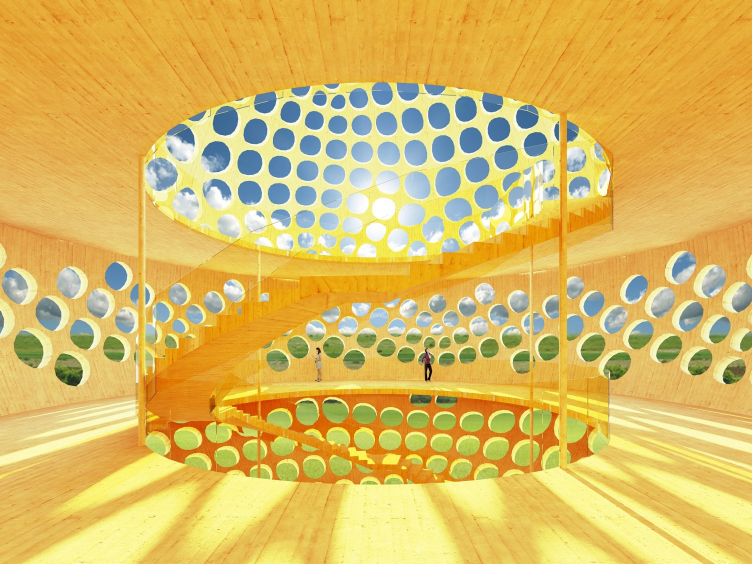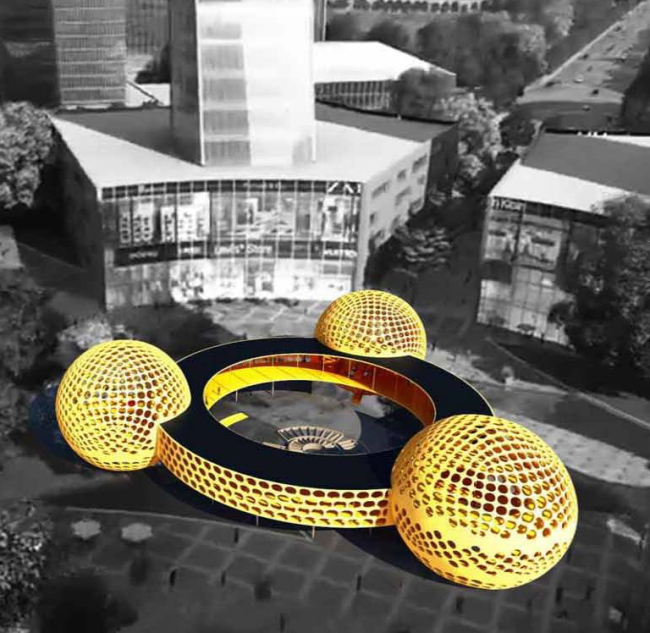
"Chak-Chak" Showroom © Totan Kuzembaev Architectural Studio
SMART City Kazan is Tatarstan Republic's new financial and business center that is being built on an area of 650 hectares, 3 kilometers away from Kazan airport, and 15 kilometers away from the city itself. It is expected that the complex will be built with the use of the advanced energy-efficient "smart" technologies, while its main residents will be the large international, Tatar, and Russian companies that will move their offices to SMART City. Presently, the project is still in the very first phase of its implementation (October 2 2013, the foundation stone was laid) - but its master plan has already been approved, the construction priorities have been defined, and now underway is the development of the projects for separate buildings and clusters. It is this particular piece of work that "Totan Kuzembaev Architects" took part in to get the commission for the development of a multifunctional showroom in the public and business center SMART City.
As for the showroom typology per se, it is commonly associated with this or that particular brand and demonstration of a certain product - but this time the authors were faced with quite a different challenge. In the case of SMART City, the object of showcasing was the innovation complex itself, so, apart from the expo halls, the functional program of this project also provided for offices, a conference center, and a restaurant, while the showroom was to be situated in the very heart of the complex. The public and business center SMART City, in turn, is in fact the first phase of an even greater project (the grand-scale park, the free economic zone, and the science center will be built still later on), while the location of the showroom will be its central square. In other words, the architects got by far the most "tasty" commission - to come up with the image of the structure that is destined to become, geographically and typologically, the symbol of the new city, its "ground zero".
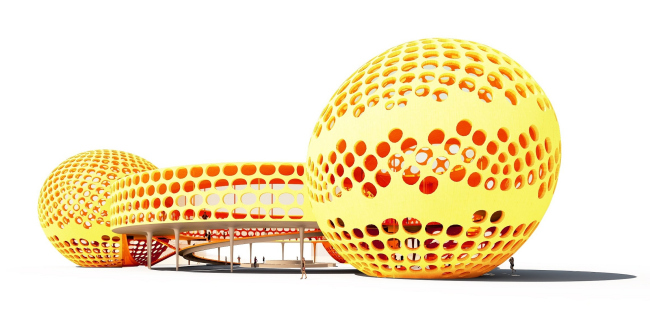
"Chak-Chak" Showroom © Totan Kuzembaev Architectural Studio
The fact that the showroom is to be located at the main pedestrian square, prompted the architects the idea of creating a structure that is partially raised above the ground - as Totan Kuzembaev explains, the last thing the architects wanted to do was to block the perspective of the incoming streets and rob the people of the central public territory. Quite the other way around - the architects wanted to highlight its importance in the structure of the complex, creating here not only a great place for walking and recreation but also decorating it with some symbol of improvement and landscaping that would eloquently stress the significance of this place and the new city in general. Such a symbol became of the composed of natural stone maquette of Arkaim - the famous ancient town from the "Country of Towns" that served as the observatory and the science center of the civilization. "Actually, just like today's SMART City, that is meant to play the part of the contemporary Tatarstan's research center" - Totan Kuzembaev explains his choice.
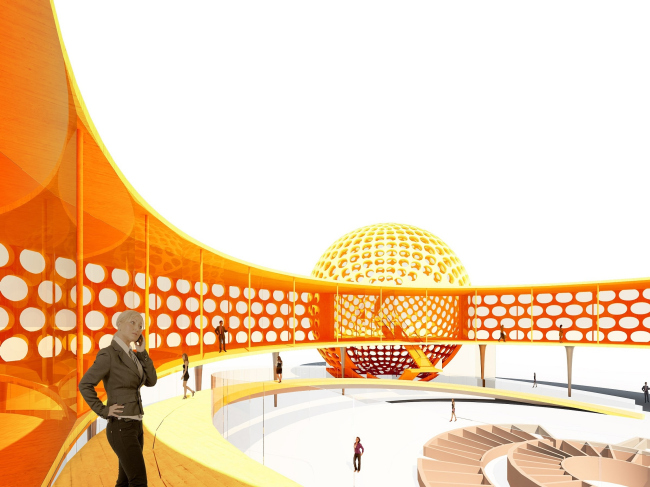
"Chak-Chak" Showroom © Totan Kuzembaev Architectural Studio
The ancient city that had circular walls, also became the prototype for the compositional solution of the showroom. The building has the shape of a hoop hovering above the square and supported by three spheres. To be more exact, the hoop is instilled into the spheres exactly in the middle, so the building gets three entrances, three distinct, separated by spaces, premises on the first floor, a single second floor, and several fully independent rooms on the third floor. Futurist as it is, such a composition perfectly matches the diverse functional program - the architects were able to completely separate the expo space, the conference halls, and the restaurants. The role of the "connective tissue" is played by the offices - they are situated along the major radius of the hoop, while the minor radius presents a public-accessed gallery, from which the relief of the ancient Arkaim is plainly visible.
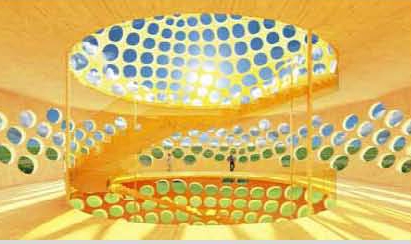
"Chak-Chak" Showroom © Totan Kuzembaev Architectural Studio
This whole thing could have looked a bit too much too serious and on the "high-profile" side, had it not been for Totan Kuzembaev entwining into the architectural image of the complex yet another theme - namely, that of "chak-chak", the "trademark" Tatart sweet treat. "I wanted to throw in a little bit of sugar" - he explains. Chak-chak is, as is known, dough balls that are first roasted and then are covered with honey - consequently, this ready-to-serve sweet delight, first of all, has a golden honey hue, and, second of all, is all full of holes. In order to convey the golden structure as true-to-life as possible, the architects used the golden glazing and the composite material Arch-Skin. The windows, in the traditional sense of the word, are non-existent here - the entire facade is in fact a surface that is evenly perforated, which makes the building look as if it was clad in lace. The central tier is fully coated that way, while the spheres, on the other hand, sport two solid bands: the architects deliberately decided to mark the intermediate floors so as to make the structure of the complex more readable for the side observes.
Naturally, it is expected that the building that is built in the innovation city is to employ advanced "smart" technologies itself. The project provides for the energy-efficient plan of the building that uses thermodynamic heat pumps, solar batteries, energy-saving lights as well as the presence sensors. And, even though the project of the showroom still remains but one of the concepts, there are reasons to think that it will organically complement the landscape of SMART City Kazan.

"Chak-Chak" Showroom © Totan Kuzembaev Architectural Studio








